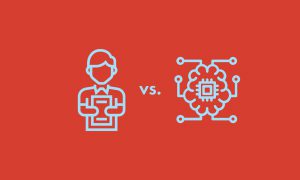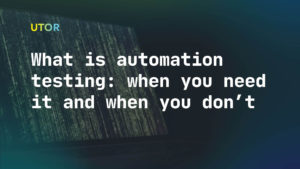“Don’t worry about that, it’s all automated” – how does that make you feel? Chances are, the emotion you’d experience is a relief. Who wouldn’t want a portion of work to disappear, anyway?
Software developers definitely would: They know the cost of mistakes that might appear as the result of manual overload. Shipping a buggy product can easily result in losing a client.
At UTOR, we know a thing or two about buggy products: Being experts in automated and manual testing, we deal with bug fixes daily. Adopting DevOps practices opens up additional possibilities. We push our clients to integrate CI/CD pipelines into their software development cycle for continuous testing capabilities.
To prevent such scenarios from happening, software developers have created a set of practices, aimed at continuous product improvement. One of those is the CI/CD pipeline which we’ll talk about in greater detail in this article.
What Is a CI/CD pipeline?
CI/CD pipeline is a combination of two DevOps frameworks – continuous integration and continuous delivery. Bonded together, they form a product release automation pipeline.
Version Control
Version control is integral in software development: Platforms like GitHub or GitLab are regarded as industry standards nowadays when it comes to storing your project updates as separate versions.
In the CI/CD process, there’s a similar idea – it’s an iterative deployment of your project changes.
Continuous Integration (CI)
DevOps practices and Agile methodology go hand-by-hand: Each sprint is often followed by a release procedure. Once your development team is done with a certain part of a project, they would typically test it before deploying it to the production environment.
That means involving at least several company departments: software development, QA automation, and system admins.
As far as multiple project contributors are involved, there is a risk of confusion if one of the chain links fails. To avoid such mixups, the CI automation tools eliminate the human involvement factor. Developers can always have a ready build for deployment once isolated pieces of code are merged with a shared mainline and thoroughly checked by leveraging AI and ML in testing.
Continuous Delivery (CD)
Continuous delivery is a logical continuation of CI, forming together a release pipeline. Not to be confused with continuous deployment (which is the next stage of the pipeline), continuous delivery is a process responsible for merging the build with a central repository.
Having a proper CD process in place helps significantly reduce the team’s burnout and establish a sustainable release roadmap.
CI/CD Tools – What’s New?
There’s no shortage of CI/CD tools: There are far too many great options to choose from. You can pick an open-source option or not, on-premise or hosted, a wide range of included features, or a single-purpose solution – this list doesn’t exhaust!
Tools like Jenkins, CIrcleCI, TeamCity, Bamboo, or GitLab have been around for a while. But here are some newbies.
GitHub Actions is a new kid on the block. Released in 2019, it’s pretty much in line with a general GitHub’s philosophy: It’s open-source and is all about community, meaning there are many free options. Apart from a great variety of features such as matrix workflows and built-in secret storage, you get free 2000 minutes of runtime environments per month.
The Benefits of CI/CD Pipeline
CI/CD workflow is your operational backbone: It allows for effortless and seamless code delivery. But what does that mean for business?
Business Continuity
Your service flow is completely uninterrupted, leaving very little room for unforeseen obstacles that would otherwise happen as the result of human involvement. You don’t need to take your chances – just let the automation have it all figured out for you.
Faster Mean Time To Resolution (MTTR)
In the business world, failures may happen sometimes. When they do happen, a timely response is critical: downtime can result in lost business opportunities.
Fixing a broken software component can be difficult if you don’t know where to look. Identifying the source of the problem can be time-consuming even if the issue is an easy fix. CI/CD keeps the risk of such mistakes at a minimum, allowing your team to focus on more critical aspects, therefore, improving MTTR.
Data Integrity
Sensitive data can be an issue when dealing with contractors, using which is quite common in software development. If you’re using a QA outsourcing team, for instance, you could allow them to perform testing against the container’s image rather than having them pull a build’s duplicate from the CI server.
Decreased Backlog
Backlog can get filled up pretty quickly if you keep getting your releases postponed. Timely releases help manage a backlog and sustain the deployment flow. As a result – a clear backlog where managers can prioritize tasks easily.
OK, how Do I Get Started?
Ready to make your move? This is how to get started.
Stick to Your Roots
We at UTOR have seen some startup projects that looked like a house of cards – change one tiny bit and the whole thing falls apart. That can be a result of the codebase’s inconsistency which might appear if changes to the source code are made too frequently.
The first rule of getting started with the CI/CD strategy: your source code is untouchable, all changes must be versioned.
Be Patient and Consistent
You might be tempted to do everything at once, and that’s exactly where caution should be applied. Embracing CI/CD all at once can be costly, and if you have no previous experience, you’re likely to come across some difficulties.
The best way to go about it is to define which processes need to be automated first. For instance, if your team does regression testing on a daily basis, that might be a good starting point.
Make Sure to Measure
At the end of the day, the ultimate goal of adopting the CI/CD pipeline is the measurable impact on your business. Once you start integrating CI/CD, make sure to measure the result of your digital transformation efforts.
FAQ
Here are the most frequently asked questions about the CI/CD pipeline.
Why is CI/CD Important?
CI/CD improves the qualitative aspect of the software development process, helping ship bug-free product updates faster. By automating a release pipeline, all potential issues can be discovered at the pre-deployment stage. No bug will go unnoticed.
What Is the Advantage of CI/CD?
Less uncertainty. Code changes occur more frequently and if something goes wrong, there’s always a possibility of a rollback. CI/CD enhances Agile principles so the development team can plan releases whenever they want while being less dependent on the other company’s departments.
Why Do We Need a CI/CD Pipeline?
Quite frankly, it’s hard to imagine any large-scale project without a properly established release pipeline nowadays. At some point, any organization reaches the level (hopefully) where maintaining product release manually becomes limiting.
What Is the Benefit of a Deployment Pipeline?
Many business owners notice that costs might initially spark up when they only start adopting DevOps at their companies. In the long run, however, there’s a noticeable trend of higher IT performance overall.
Final thoughts
Business automation is gaining momentum: there’s a lot of talk about the benefits it brings. What gets overlooked is a simple fact that such automation endeavors fail sometimes.
As much as we encourage everyone to adopt DevOps, we do not recommend doing it just for the sake of doing it: there must be a good reason for your organization to make the decision of going down that route.
As far as automated testing is concerned, having a release pipeline significantly improves testing time and fixes deployment. UTOR uses an isolated testing environment, pulling a staging environment duplicate for regression testing. Once we’re finished build testing, we merge the final version with the production mainline. This approach allows for seamless collaboration, so we don’t interfere with our client’s development team.
In case you’re not sure whether CI/CD pipeline is the right choice for you, we recommend consulting professionals first.







